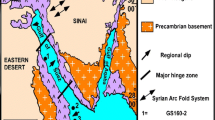Abstract
This is a preliminary study on the microtektites that were found in large numbers from the interval between 7.80 and 8.10 m depth of core S095-17957-2 (10°53.9’N, 115°18.3’E, water depth 2 195 m), northern Nansha area of the South China Sea. The microtektites vary in shape, with spherules predominating, and are commonly less than 1 mm in diameter, transparent or semitransparent, brownish in color, with bubbles inside. Based on coarse fraction stratigraphy and foraminifera/nanofossil biostratigraphical events the microtektite layer was assigned to nearly the Bm-hes/Matuyama magnetic reversal boundary (some 0.78 MaBP). Obviously, the present microtektites, and those found from the middle Pleistocene of the Indian Ocean, Australia and loess of northern China, were products of the same impact event and therefore, are useful as a reliable mark in Quaternary stratigraphy, as well as in paleoclimatic studies.
Similar content being viewed by others
References
Sarnthein, M., Pflaumann, U., Wang, P. eta1. (eds.),Preliminary Report on Some-95Cruise “Monitor Monsoon” to the South China Sea, Kiel: Berichte-Reports, Geol-Paläont Inst. Univ. Kiel, 1994, 68: 1.
Bassinot, F. C., Beaufort, L., Vincent, E. et al., Coars fraction fluctuations in pelagic carbonate sediments from the tropic Indian Ocean: a 1 500-kyr record of carbonate dissolution,Paleoceanography, 1994, 9(4): 579.
Thompson, P. R., Be, A. H. W., Duplessy, J. C. et al., Disappearance of pink-pigmentedGlobigerinoides ruber at 120 000 yrBP in the Indian and Pacific Oceans,Nature, 1977, 280: 554.
Thierstein, H. R., Geitzenauer, K. R., Molfino, B. et al., Global synchroneity of late Quaternary coccolith datum levels: validation by oxygen isotopes,Geology, 1977, 5: 400.
Schonfeld, J., The “Stilostomella extinction”, Structure and dynamics of the last turnover in deep-sea benthic foraminifera1 assemblages, inMicrofossils and Oceanic Environments (eds. Mongurlevsky, A., Whatley, R.), Aberystwyth: University of Wales, Aberystwyth-Press, 1996. 27–37.
Schackleton, N. J., Berger, A., Peltier, W. R., An alternative astronomical calibration of the lower Pleistocene time scale based on ODP site 677,Trans. R. Soc. Edinburgh Earth Sci., 1990, 81: 251.
Baksi, A. K., Hsu, V., Mc Williams, M. O. et al.,40Ar/39Ar dating of the Brunhes-Matuyama geomagnetic field reversal,Science, 1992, 256: 356.
Berger, W. H., Bickert, T., Schmidt, H. et al., Quaternary oxygen isotope record of pelagic foraminifers, site 806, Ontong Java Plateau,Proc ODP, Sci. Res., 1993, 130: 381.
Glass, B. P., Microtektites in deep-sea sediments,Nature, 1967, 214: 373.
Cassidy, W. A., Glass, B. P., Heezen, B. C., Physical and chemical properties of Australian microtektite,J. Geophysical Res., 1969, 74: 1 008.
Li Chunlai, Ouyang Ziyuan, Liu Tungsheng et al., Microteklites and glassy microtektites in loess: Their discovery and implications,Science in China, Ser. B, 1993, 36(9): 1141
Xu Heling, Wu Xihao, Deng Jiwen et al., Discovery of the unusual micrograins in the loess strata and their preliminary studies,Marine Geol. Quatern. Geol. (in Chinese with Engligh abstract), 1993, 13(3):57.
Smith, J., van Eijden, A. J. M., Troelstra, S. R., Analysis of the Australasian microtektite event, the Toba Lake event, and the Cretaceous/Paleogene boundary, eastern Indian Ocean, in Roc. ODP, Sci. Res. ((eds. Weissel, J., Peirce, J., Taylor, E. et al.), 1991, 121: 489–503.
Li Chunlai, Ouyang Ziyuan, Progress in the (micro-)tektite study,Chinese Science Bulletin (in Chinese), 1997, 42(16): 1681.
Li Chunlai, Lin Wenzhu, Ouyang Ziyuan, Geochemistry of 0.7 Ma B.P. microtektite bearing loess layer—I. Stablecarbon isotopic,Chinese Science Bulletin, 1994, 39(7): 629.
Glass, B. P., Possible correlation between tektite events and climatic changes?Spec. Pap. Geol. Soc. Am., 1982, 180: 251.
Author information
Authors and Affiliations
Additional information
Project supported by the National Natural Science Foundation of China (Grant Nos. 49676287, 49732060).
Rights and permissions
About this article
Cite this article
Zhao, Q., Jian, Z., Li, B. et al. Microtektites in the Middle Pleistocene deep-sea sediments of the South China Sea*. Sci. China Ser. D-Earth Sci. 42, 531–535 (1999). https://doi.org/10.1007/BF02875247
Received:
Issue Date:
DOI: https://doi.org/10.1007/BF02875247




